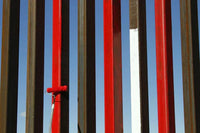Why care for your wrought iron? Speaking as someone who works with wrought iron every day, keeping your fences and railings in top shape is about more than appearances—though it definitely enhances curb appeal. It’s also a matter of safety. Rust and damage can compromise the strength of the structure, turning a durable feature into a weak spot. Regular upkeep ensures your ironwork stays reliable, safe, and visually appealing for years to come.
First Things First: Check It Out and Prepare
Check your wrought iron regularly for rust spots, cracks, or any signs of wear and tear that could weaken the structure. Even small issues, like chipped paint or minor rust, can spread over time if left unattended, so catching them early is key to keeping your ironwork in good condition.
Gear Up
Always wear protective gear like gloves, safety glasses, and a mask when working on wrought iron to shield yourself from sharp edges, rust particles, and chemical exposure. Skipping this step can lead to injuries like cuts from jagged metal or irritation from rust dust and fumes. Accidentally inhaling rust particles while sanding could cause serious respiratory issues. Taking a few minutes to gear up ensures your safety throughout the job.
Prep the Area
Lay down some old sheets or tarps around your work area to catch debris, like rust flakes, paint chips, and dust. Otherwise, you get a messy cleanup or, worse, rust particles settling on other surfaces, which could cause staining or damage over time.
Strip Away the Rust and Paint
Use wire brushes or sandpaper to remove rust and flaky paint effectively. For heavy rust, a stiff wire brush with stainless steel bristles works best—it’s tough enough to cut through corrosion without damaging the metal underneath. For tighter spots or detailed areas, opt for smaller brushes with finer bristles to ensure precision.
Sandpaper is ideal for smoothing the surface after brushing or for dealing with lighter rust and paint. Start with a coarse grit (around 80-120) to break down the rough areas, then switch to a finer grit (200-400) for a smooth finish that’s ready for priming and painting.
Chemical Help
Apply rust neutralizers to stop corrosion in its tracks and protect your wrought iron. Look for products labeled as rust converters or rust inhibitors—these chemically transform rust into a stable, paintable surface. Liquid formulas, like those with tannic acid or phosphoric acid, work well for large, flat areas, while gel-based options are great for vertical surfaces or intricate details where you need more control. Brands like Rust-
Rust-Oleum Reformer or Corroseal are reliable choices. Always follow the product instructions and use a brush or sprayer for even application. Neutralizing rust before painting is crucial to prevent it from spreading and ensures your ironwork stays strong and durable.
Get the Fence or Railing Surface Ready
Wash Up
Wash the wrought iron fences or railings thoroughly with warm soapy water to remove dirt, grime, and any leftover debris from sanding or brushing. This step ensures a clean surface, helping primers and paints adhere better while preventing any contaminants from interfering with the protective coatings.
Smooth It Out
Smooth the wrought iron surface with sandpaper to prepare it for painting. As I mentioned earlier, start with medium-grit paper for rough spots and switch to fine-grit for a polished finish. This step ensures the surface is even and ready for the primer and paint to adhere properly, helping to prevent peeling or uneven coverage down the line.
Repair the Damage
-
Using Epoxy Putty for Small Cracks: For small cracks in wrought iron, epoxy putty is a simple and effective solution. Cut or knead the putty as directed on the package, then press it firmly into the crack, shaping it to match the surrounding surface. Once applied, allow it to cure completely - this usually takes a few hours, depending on the product. After it hardens, sand it down for a smooth finish before priming and painting.
-
Welding for Larger Breaks: For larger breaks or structural damage, welding is the go-to solution, but it’s a more serious venture. It requires specialized equipment, like a welding machine, and protective gear to handle the intense heat and sparks safely. Because of the precision and skill involved, it’s best to call a professional for this kind of repair. Improper welding can weaken the structure or even cause further damage, so leaving it to an expert ensures the repair is done safely and correctly.
- Bent Parts: If parts of your wrought iron are bent, you can gently straighten them using the right tools. A rubber mallet is great for making controlled adjustments without damaging the surface, while a vise or clamps can help secure the piece as you work. For more precision, a pipe wrench or a heat gun can be useful for adjusting thicker or more stubborn sections. If the bends are severe or the area is difficult to access, it’s a good idea to call a professional. They’ll have the experience and equipment needed to straighten the iron safely without causing further damage.
Finishing Touches of Repair Process
Priming
Applying a rust-inhibiting primer is a crucial step to protect your wrought iron fences and railigs and prevent future rust. These primers form a barrier that stops moisture from reaching the metal, which is key to long-term durability. Products like Rust-Oleum Rusty Metal Primer or Krylon Rust Tough Primer are excellent choices for their strong adhesion and anti-corrosion properties. For areas prone to extreme weather, consider using Corroseal Rust Converter, which also neutralizes existing rust. Always apply the primer in thin, even coats, and let it dry completely before painting to ensure maximum protection.
Painting
When choosing a paint for your wrought iron, opt for a durable metal paint that’s specifically formulated to withstand outdoor conditions. Look for paints with weather resistance, UV protection, and rust prevention to ensure a long-lasting finish. Below is a table highlighting three top-rated metal paints and their key characteristics:
|
Paint Name |
Finish | Features |
Best For |
Drying Time |
|
Rust-Oleum Protective Enamel |
Gloss, Satin, Flat |
Rust-resistant, weatherproof, long-lasting |
Fences, gates, and railings |
2-4 hours to touch |
|
Krylon Dual Superbond Paint + Primer |
Satin, Matte |
Primer and paint in one, excellent adhesion, fade-resistant |
Outdoor metal furniture and railings |
1 hour to touch |
|
Hammered, Smooth |
Direct application to rust, UV-resistant, waterproof |
Wrought iron with existing rust |
1-2 hours to touch |
Enamel coating
Adding a protective enamel coat to your wrought iron provides an extra layer of durability, shielding it from weather, wear, and corrosion. Enamel coatings create a hard, glossy finish that enhances the paint’s longevity and adds a professional touch. Below is a table with three recommended protective enamel coatings and their key characteristics:
| Enamel Name | Finish | Features | Best For | Drying Time |
|
Rust-Oleum Stops Rust Clear Enamel |
Clear Gloss, Satin |
Protects against UV rays, prevents chipping and cracking |
Fences, railings, and gates |
2-4 hours to touch |
|
Minwax Helmsman Spar Urethane |
Gloss, Semi-Gloss |
Waterproof, resists sunlight and moisture, long-lasting |
Outdoor furniture and iron accents |
4-6 hours to touch |
|
Clear Gloss |
Quick-drying, non-yellowing, protects against weather damage |
Small iron details and railings |
1 hour to touch |
Long-Term Care: Keep Your Wrought Iron Fences and Railings in Top Shape
Inspect your ironwork every few months to catch potential problems early—this step ties together everything we’ve discussed. Look for rust, peeling paint, or cracks that might weaken the structure, as well as bends or loose sections that need adjustment. Check the joints, connections, and any areas where water might collect, as these are prone to rust. This quick inspection acts as a summary of all the key maintenance points covered in this article, helping you keep your wrought iron strong, safe, and visually appealing.
Wash your wrought iron regularly with soapy water to prevent dirt and rust buildup. A simple rinse every few months helps keep the surface clean and stops grime from trapping moisture, which can lead to corrosion.
Here’s a quick tip: Address small problems early to avoid bigger headaches later.
Conclusion
Maintaining your wrought iron railings or fences doesn’t have to be a daunting task. With a little attention and the right steps, keeping them in great shape is straightforward and rewarding. Follow this guide, and I can confidently say you’ll handle the job just fine—your ironwork will stay strong, beautiful, and ready to stand the test of time.









